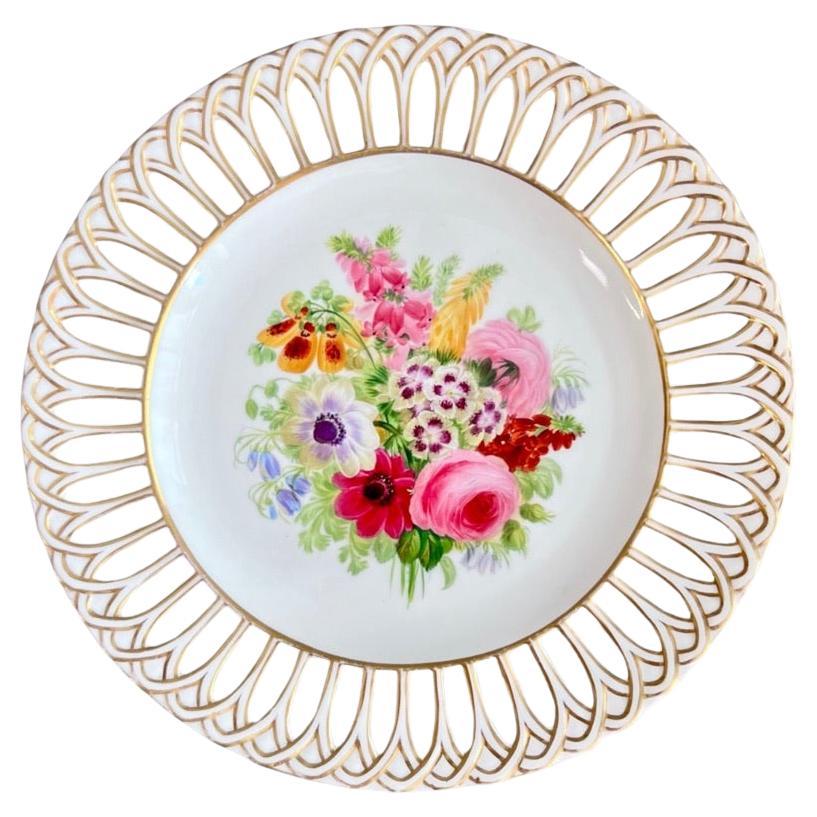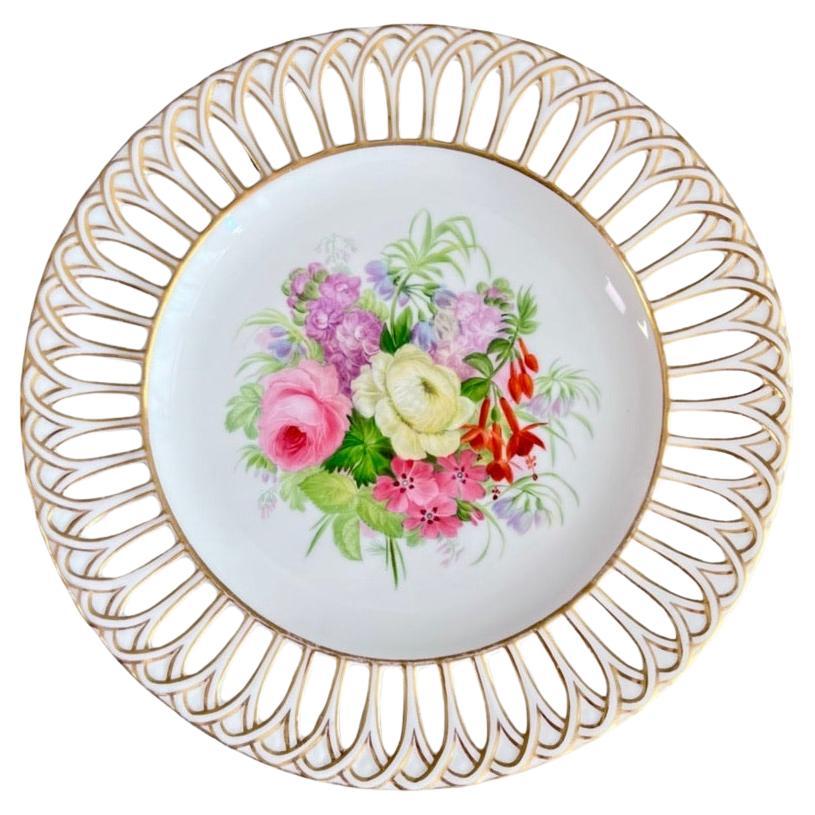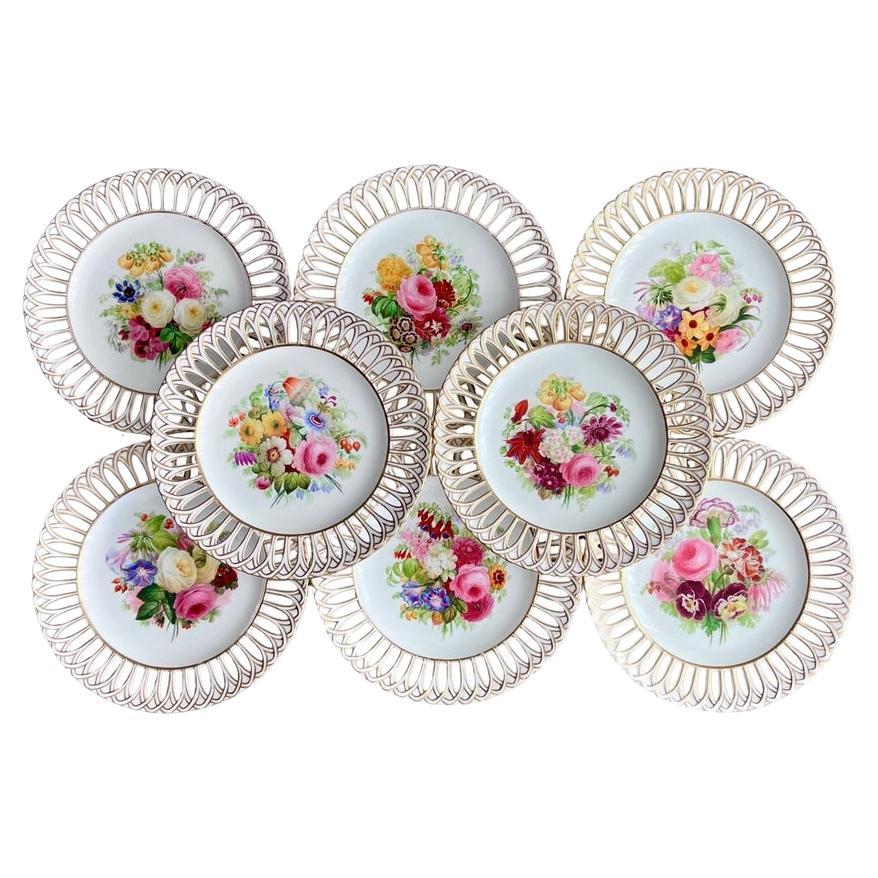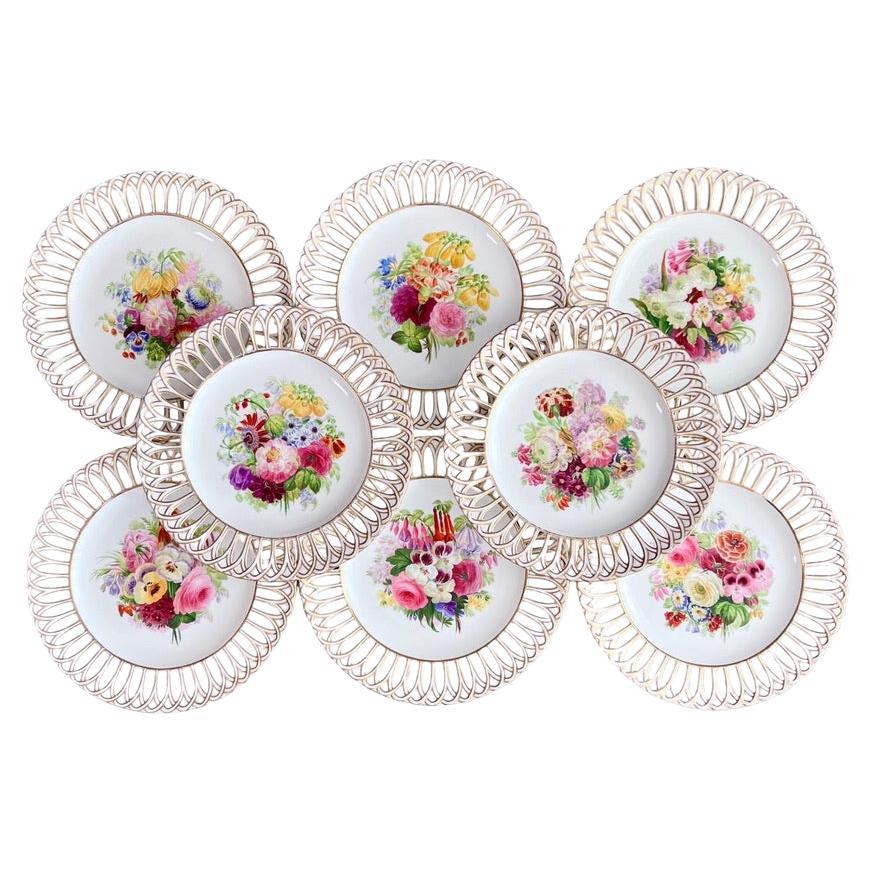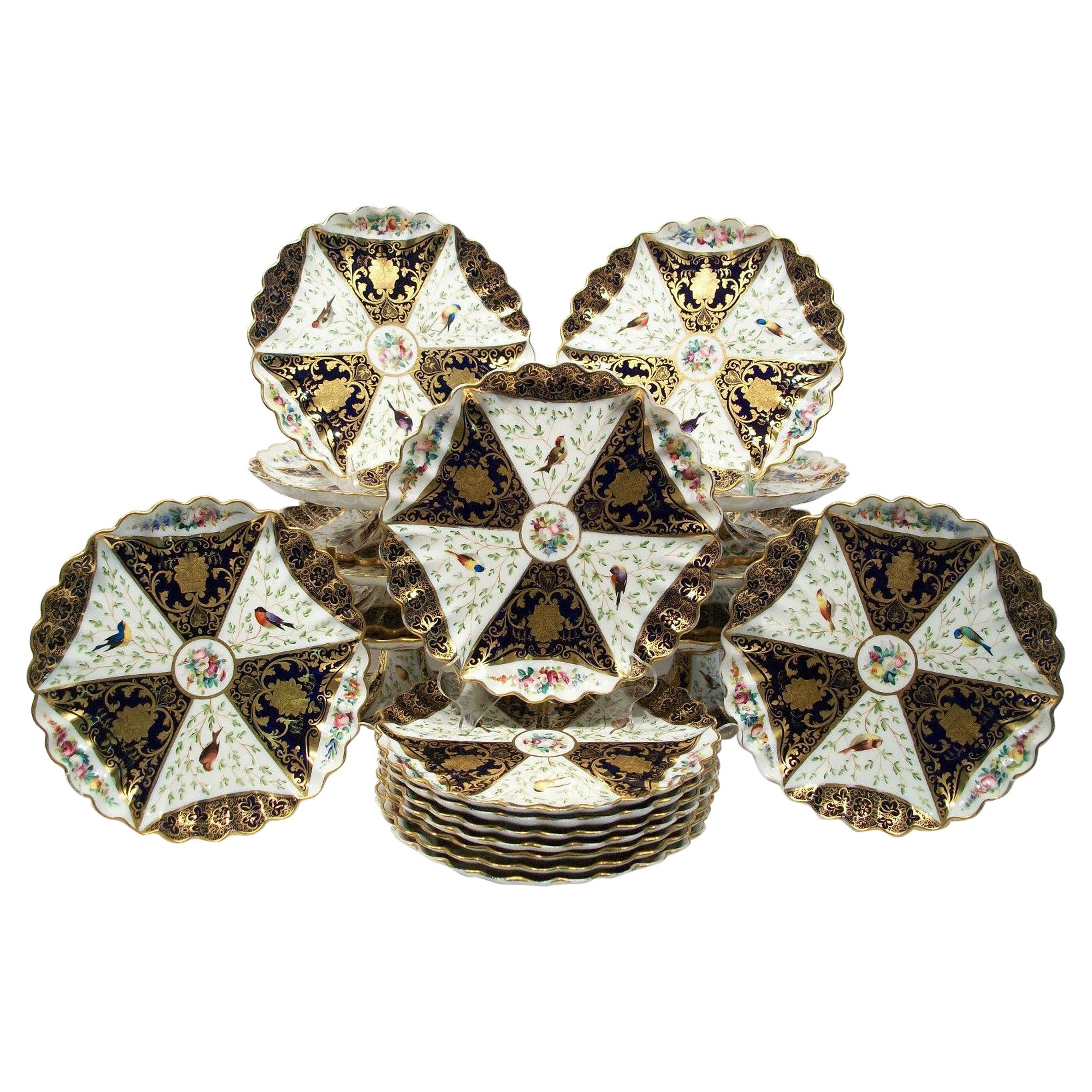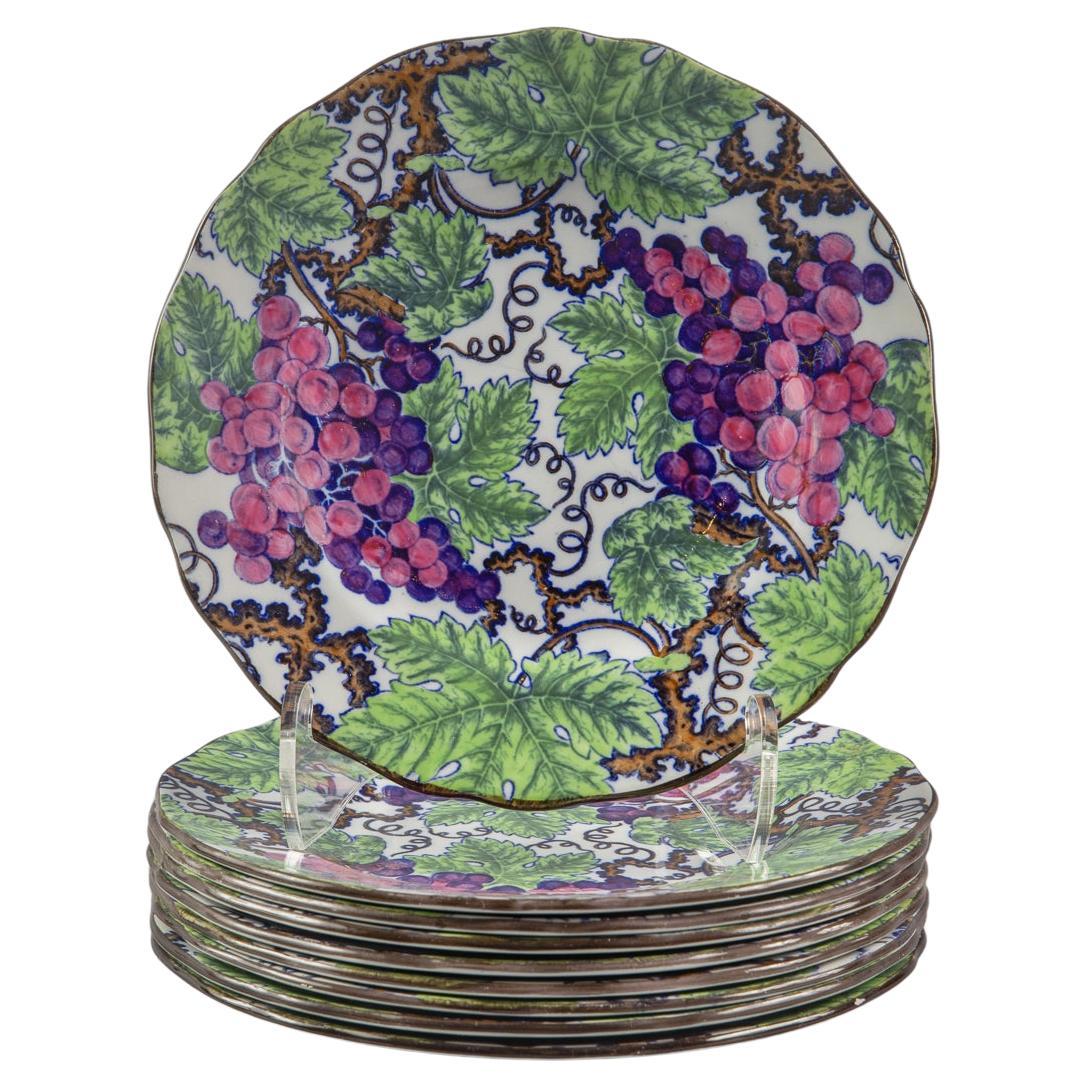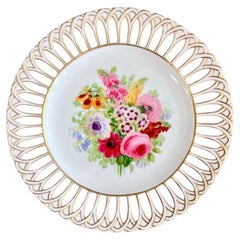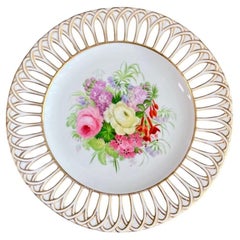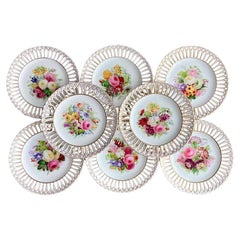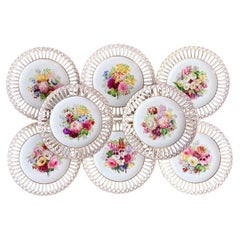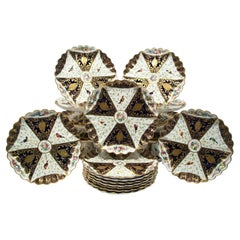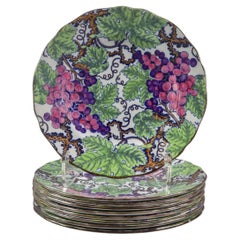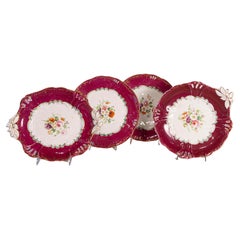Items Similar to Copeland dessert Plate, Reticulated, Sublime Flowers by Greatbatch, 1848 (1)
Video Loading
Want more images or videos?
Request additional images or videos from the seller
1 of 15
Copeland dessert Plate, Reticulated, Sublime Flowers by Greatbatch, 1848 (1)
About the Item
This is a beautiful plate made by Copeland in 1848. It is decorated with a sublimely painted flower arrangement by the artist Greatbatch.
We have two sets of 8 of these plates available, as well as a few more separate ones; please see separate listings.
The Copeland factory was the third iteration of the famous Spode factory, after the "Copeland & Garrett" period which transitioned into the "Copeland" period in about 1833. The Spode/Copeland factory was one of the most prominent potteries right from the start of English porcelain production in the late 1700s to the demise of the industry in the 1960s and ultimate closure in the early 21st Century. In fact it was the founder Josiah Spode who was responsible for the recipe for bone china that made English china production so successful in the two centuries to come. Throughout all the changes, their items have always remained of exceptionally high quality and many of the designs have become iconic.
This plate was potted in fine white bone china, the rim meticulously reticulated in the "Gothic" shape. Reticulation was very time consuming and difficult, and just this detail would have made this plate expensive. The sublimely painted flower arrangement painted in the centre were done by Greatbatch, one of the well-known floral artists working for Copeland. Greatbatch was active between 1845 and 1860, and worked together with his brother R. Greatbatch, who was a talented gilder. They exhibited at the Great Exhibition of 1851.
This plate would have belonged to a sublimely expensive dessert service. It is stamped with the small blue Copeland mark with interlocking C's, and painted in red with the pattern number 7913, dating it at the year 1848.
Documentation: A plate of this service is shown on page 80 of Steven Smith's "Spode & Copeland: Over Two Hundred Years of Fine China and Porcelain". References to the painter can be found on page 213 and 257 of Vera Wilkinson's "Spode-Copeland-Spode: The Works And Its People 1770-1970".
CONDITION REPORT The plate is in very good condition without any damage or repairs, but it is crazed and there is some associated discolouration on the back only. There is a little wear as visible in the pictures.
Antique British porcelain is never perfect. Kilns were fired on coal in the 1800s, and this meant that china from that period can have some firing specks from flying particles. British makers were also known for their experimentation, and sometimes this resulted in technically imperfect results. Due to the shrinkage in the kiln, items can have small firing lines or develop crazing over time, which should not be seen as damage but as an imperfection of the maker's recipes, probably unknown at the time of making. Items have often been used for many years and can have normal signs of wear, and gilt can have signs of slight disintegration even if never handled. I will reflect any damage, repairs, obvious stress marks, crazing or heavy wear in the item description but some minor scratches, nicks, stains and gilt disintegration can be normal for vintage items and need to be taken into account.
There is widespread confusion on the internet about the difference between chips and nicks, or hairlines and cracks. I will reflect any damage as truthfully as I can, i.e. a nick is a tiny bit of damage smaller than 1mm and a chip is something you can easily see with the eye; a glazing line is a break in the glazing only; hairline is extremely tight and/or superficial and not picked up by the finger; and a crack is obvious both to the eye and the finger. Etcetera - I try to be as accurate as I can and please feel free to ask questions or request more detailed pictures!
DIMENSIONS (diameters): 24cm (9.5").
- Creator:Copeland (Maker)
- Dimensions:Height: 0.75 in (1.91 cm)Diameter: 9.5 in (24.13 cm)
- Style:Victorian (Of the Period)
- Materials and Techniques:
- Place of Origin:
- Period:
- Date of Manufacture:1848
- Condition:Wear consistent with age and use. The plate is in very good condition without any damage or repairs, but it is crazed and there is some associated discolouration on the back only. There is a little wear as visible in the pictures.
- Seller Location:London, GB
- Reference Number:Seller: LT-SPO03-31stDibs: LU4805139522302
About the Seller
5.0
Gold Seller
Premium sellers maintaining a 4.3+ rating and 24-hour response times
Established in 2016
1stDibs seller since 2019
225 sales on 1stDibs
Typical response time: 2 hours
- ShippingRetrieving quote...Shipping from: London, United Kingdom
- Return Policy
Authenticity Guarantee
In the unlikely event there’s an issue with an item’s authenticity, contact us within 1 year for a full refund. DetailsMoney-Back Guarantee
If your item is not as described, is damaged in transit, or does not arrive, contact us within 7 days for a full refund. Details24-Hour Cancellation
You have a 24-hour grace period in which to reconsider your purchase, with no questions asked.Vetted Professional Sellers
Our world-class sellers must adhere to strict standards for service and quality, maintaining the integrity of our listings.Price-Match Guarantee
If you find that a seller listed the same item for a lower price elsewhere, we’ll match it.Trusted Global Delivery
Our best-in-class carrier network provides specialized shipping options worldwide, including custom delivery.More From This Seller
View AllCopeland Plate, Reticulated, Sublime Flowers by Greatbatch, 1848 (3)
By Copeland
Located in London, GB
This is a beautiful plate made by Copeland in 1848. It is decorated with a sublimely painted flower arrangement by the artist Greatbatch.
We have two sets of 8 of these plates available, as well as a few more separate ones; please see separate listings.
The Copeland factory was the third iteration of the famous Spode factory, after the "Copeland & Garrett" period which transitioned into the "Copeland" period in about 1833. The Spode/Copeland factory was one of the most prominent potteries right from the start of English porcelain production in the late 1700s to the demise of the industry in the 1960s and ultimate closure in the early 21st Century. In fact it was the founder Josiah Spode who was responsible for the recipe for bone china that made English china production so successful in the two centuries to come. Throughout all the changes, their items have always remained of exceptionally high quality and many of the designs have become iconic.
This plate was potted in fine white bone china, the rim meticulously reticulated in the "Gothic" shape. Reticulation was very time consuming and difficult, and just this detail would have made this plate expensive. The sublimely painted flower arrangement painted in the centre were done by Greatbatch, one of the well-known floral artists working for Copeland. Greatbatch was active between 1845 and 1860, and worked together with his brother R. Greatbatch, who was a talented gilder. They exhibited at the Great Exhibition of 1851.
This plate would have belonged to a sublimely expensive dessert service. It is stamped with the small blue Copeland mark with interlocking C's, and painted in red with the pattern number 7913, dating it at the year 1848.
Documentation: A plate of this service is shown on page 80 of Steven Smith's "Spode & Copeland: Over Two Hundred Years of Fine China and...
Category
Antique 1840s English Victorian Dinner Plates
Materials
Porcelain
Copeland Plate, Reticulated with Sublime Flowers by Greatbatch, 1848 (2)
By Copeland
Located in London, GB
This is a beautiful plate made by Copeland in 1848. It is decorated with a sublimely painted flower arrangement by the artist Greatbatch.
We have two sets of 8 of these plates available, as well as a few more separate ones; please see separate listings.
The Copeland factory was the third iteration of the famous Spode factory, after the "Copeland & Garrett" period which transitioned into the "Copeland" period in about 1833. The Spode/Copeland factory was one of the most prominent potteries right from the start of English porcelain production in the late 1700s to the demise of the industry in the 1960s and ultimate closure in the early 21st Century. In fact it was the founder Josiah Spode who was responsible for the recipe for bone china that made English china production so successful in the two centuries to come. Throughout all the changes, their items have always remained of exceptionally high quality and many of the designs have become iconic.
This plate was potted in fine white bone china, the rim meticulously reticulated in the "Gothic" shape. Reticulation was very time consuming and difficult, and just this detail would have made this plate expensive. The sublimely painted flower arrangement painted in the centre were done by Greatbatch, one of the well-known floral artists working for Copeland. Greatbatch was active between 1845 and 1860, and worked together with his brother R. Greatbatch, who was a talented gilder. They exhibited at the Great Exhibition of 1851.
This plate would have belonged to a sublimely expensive dessert service. It is stamped with the small blue Copeland mark with interlocking C's, and painted in red with the pattern number 7913, dating it at the year 1848.
Documentation: A plate of this service is shown on page 80 of Steven Smith's "Spode & Copeland: Over Two Hundred Years of Fine China and...
Category
Antique 1840s English Victorian Dinner Plates
Materials
Porcelain
Copeland Set of 8 plates, Reticulated, Sublime Flowers by Greatbatch, 1848
By Copeland
Located in London, GB
This is a stunning set of 8 reticulated plates made by Copeland in 1848. Each plate is decorated with a unique sublimely painted flower arrangement by the artist Greatbatch.
We have a second set of 8 of these plates available, as well as a few separate ones; please see separate listings.
The Copeland factory was the third iteration of the famous Spode factory, after the "Copeland & Garrett" period which transitioned into the "Copeland" period in about 1833. The Spode/Copeland factory was one of the most prominent potteries right from the start of English porcelain production in the late 1700s to the demise of the industry in the 1960s and ultimate closure in the early 21st Century. In fact it was the founder Josiah Spode who was responsible for the recipe for bone china that made English china production so successful in the two centuries to come. Throughout all the changes, their items have always remained of exceptionally high quality and many of the designs have become iconic.
These plates were potted in fine white bone china, the rims meticulously reticulated in the "Gothic" shape. Reticulation was very time consuming and difficult, and just this detail would have made these plates expensive. The sublimely painted flower arrangements in the centre were done by Greatbatch, one of the well-known floral artists working for Copeland. Greatbatch was active between 1845 and 1860, and worked together with his brother R. Greatbatch, who was a talented gilder. They exhibited at the Great Exhibition of 1851.
These plates would have belonged to a sublimely expensive dessert service. They are all stamped with the small blue Copeland mark with interlocking C's, and painted in red with the pattern number 7913, dating it at the year 1848.
Documentation: A plate of this service is shown on page 80 of Steven Smith's "Spode & Copeland: Over Two Hundred Years of Fine China and Porcelain...
Category
Antique 1840s English Victorian Dinner Plates
Materials
Porcelain
Set of 8 Plates by Copeland, Reticulated, Sublime Flowers by Greatbatch, 1848
By Copeland
Located in London, GB
This is a stunning set of 8 reticulated plates made by Copeland in 1848. Each plate is decorated with a unique sublimely painted flower arrangement by the artist Greatbatch.
We have a second set of 8 of these plates available, as well as a few separate ones; please see separate listings.
The Copeland factory was the third iteration of the famous Spode factory, after the "Copeland & Garrett" period which transitioned into the "Copeland" period in about 1833. The Spode/Copeland factory was one of the most prominent potteries right from the start of English porcelain production in the late 1700s to the demise of the industry in the 1960s and ultimate closure in the early 21st Century. In fact it was the founder Josiah Spode who was responsible for the recipe for bone china that made English china production so successful in the two centuries to come. Throughout all the changes, their items have always remained of exceptionally high quality and many of the designs have become iconic.
These plates were potted in fine white bone china, the rims meticulously reticulated in the "Gothic" shape. Reticulation was very time consuming and difficult, and just this detail would have made these plates expensive. The sublimely painted flower arrangements in the centre were done by Greatbatch, one of the well-known floral artists working for Copeland. Greatbatch was active between 1845 and 1860, and worked together with his brother R. Greatbatch, who was a talented gilder. They exhibited at the Great Exhibition of 1851.
These plates would have belonged to a sublimely expensive dessert service. They are all stamped with the small blue Copeland mark with interlocking C's, and painted in red with the pattern number 7913, dating it at the year 1848.
Documentation: A plate of this service is shown on page 80 of Steven Smith's "Spode & Copeland: Over Two Hundred Years of Fine China and Porcelain...
Category
Antique 1840s English Victorian Dinner Plates
Materials
Porcelain
$7,500 / set
Free Shipping
Minton Part Dessert Service, Newcastle Embossed, Flowers J. Bancroft, 1857
By Minton
Located in London, GB
This is a stunning 12-piece part-dessert service made by Minton in 1857-1858. It is beautifully moulded in the Newcastle Embossed shape, the moulding picked out and turquoise and gil...
Category
Antique 1850s English Victorian Porcelain
Materials
Porcelain
Barr Flight & Barr Part Dessert Service, Flowers by William Billingsley, 1808-10
By William Billingsly, Barr, Flight & Barr Worcester
Located in London, GB
This is a stunning and extremely rare part dessert service made by Barr Flight & Barr in Worcester, and painted with naturalistic flowers by William Billingsley between 1808 and 1810. The service consists of one deep central oval dish, four slightly smaller oval dishes, two round one-handled dishes, and six plates.
We also have a pair of Derby ice pails available in a separate listing, painted by William Billingsley in a very similar style. These would make a great match.
Provenance: The Charles Dawson Collection. One of the items has a label of the London Ceramic...
Category
Antique Early 1800s English Regency Dinner Plates
Materials
Porcelain
$12,000 / set
Free Shipping
You May Also Like
COPELAND, Antique Gilt Porcelain Ornithological Dessert Service, Circa 1851-95
By Copeland
Located in Chatham, ON
COPELAND - Rare - museum quality - antique porcelain ornithological luncheon or dessert service - each plate and comport hand painted with three different specimens of birds against leafy branches - floral sprays to the center and border of each piece - alternating sections of cobalt blue with the finest quality gilding - each piece with fluted & scalloped edges - incredible attention to detail with the underside of the tall comports completely decorated - total of 18 pieces (12 plates - 2 tall comports - 4 short comports) - impressed letters & numbers - hand painted model number on each piece - 1/2642 - each piece with under glaze blue factory stamp - United Kingdon - circa 1851-95.
Excellent antique condition - restored tall comport - a few minor edge chips - minor gilding loss - otherwise in fine antique form...
Category
Antique Late 19th Century British Aesthetic Movement Dinner Plates
Materials
Porcelain
Set of Ten English Porcelain Dessert Plates, Copeland Spode, circa 1890
Located in New York, NY
Painted grapes on a vine. Marked on the reverse with Copeland Spode mark along with the retail mark.
Category
Antique 1890s Dinner Plates
Materials
Porcelain
Set of 14 Copeland Late Spode Aesthetic Movement Green Parrot Dessert Plates
By Copeland Spode
Located in Great Barrington, MA
This wonderful set of 14 Copeland Late Spode dessert plates will surely add color and whimsy to your place settings. This pattern was originally in...
Category
Early 20th Century English Porcelain
Materials
Porcelain
English 1850s Copeland Red Border Plates and Compotes with Bouquets of Flowers
By Copeland & Garrett Spode
Located in Atlanta, GA
A set of four English Copeland red border dessert plates and compotes from the mid 19th century, priced and sold individually. Born in England during t...
Category
Antique Mid-19th Century English Dinner Plates
Materials
Porcelain
Set of Three British Porcelain Plates with Flowers by Copeland
By Copeland
Located in London, GB
Set of three British porcelain plates with flowers by Copeland
British, c. 1880
Height 2cm, diameter 24cm
Crafted by Copeland, this charming set of three plates...
Category
Antique Late 19th Century British Dinner Plates
Materials
Porcelain
$1,315 Sale Price / set
20% Off
Set of 12 Cauldon Hand-Painted "Flower Arrangement" Dessert Plates, Cobalt Blue
By Brown, Westhead & Moore/Cauldon
Located in Great Barrington, MA
A decorative and beautifully hand-painted set of 12 Cauldon dessert plates with shaped rims trimmed in gold with central floral decoration. Each plate depicts a unique flower arrange...
Category
Antique Early 1900s British Aesthetic Movement Dinner Plates
Materials
Porcelain
Recently Viewed
View AllMore Ways To Browse
Antique Copeland
Antique English Porcelain Spode
Antique Blue And White Victorian Porcelain
Antique Copeland Spode Patterns
Antique Plates 1700s
1800s Bone China
Crystal Towel Rings
Cube Chrome Framed Cocktail Table
Culver Bamboo
Cumano Castiglioni
Cunard Steamship Line
Cupid Coffee Table
Curio Cabinet Wood Inlays Antique Glass Front
Curtis Jere Aquarium
Curtis Jere Fish Aquarium
Curtis Jere Kinetic Wave Wall Sculpture
Curtis Jere Kinetic Wave
Curtis Jere Park
